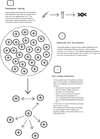Community and Provider Perspectives on Molecular HIV Surveillance and Cluster Detection and Response for HIV Prevention: Qualitative Findings From King County, Washington
- PMID: 35500058
- PMCID: PMC9062191
- DOI: 10.1097/JNC.0000000000000308
Community and Provider Perspectives on Molecular HIV Surveillance and Cluster Detection and Response for HIV Prevention: Qualitative Findings From King County, Washington
Abstract
Responding quickly to HIV outbreaks is one of four pillars of the U.S. Ending the HIV Epidemic (EHE) initiative. Inclusion of cluster detection and response in the fourth pillar of EHE has led to public discussion concerning bioethical implications of cluster detection and response and molecular HIV surveillance (MHS) among public health authorities, researchers, and community members. This study reports on findings from a qualitative analysis of interviews with community members and providers regarding their knowledge and perspectives of MHS. We identified five key themes: (a) context matters, (b) making sense of MHS, (c) messaging, equity, and resource prioritization, (d) operationalizing confidentiality, and (e) stigma, vulnerability, and power. Inclusion of community perspectives in generating innovative approaches that address bioethical concerns related to the use of MHS data is integral to ensure that widely accessible information about the use of these data is available to a diversity of community members and providers.
Copyright © 2021 Association of Nurses in AIDS Care.
Conflict of interest statement
Disclosures
The authors report no real or perceived vested interests related to this article that could be construed as a conflict of interest.
Figures
Similar articles
-
Ending the HIV Epidemic: Identifying Barriers and Facilitators to Implement Molecular HIV Surveillance to Develop Real-Time Cluster Detection and Response Interventions for Local Communities.Int J Environ Res Public Health. 2023 Feb 13;20(4):3269. doi: 10.3390/ijerph20043269. Int J Environ Res Public Health. 2023. PMID: 36833963 Free PMC article.
-
Lessons learned from community engagement regarding phylodynamic research with molecular HIV surveillance data.J Int AIDS Soc. 2023 Jul;26 Suppl 1(Suppl 1):e26111. doi: 10.1002/jia2.26111. J Int AIDS Soc. 2023. PMID: 37408448 Free PMC article.
-
HIV provider and patient perspectives on the Development of a Health Department "Data to Care" Program: a qualitative study.BMC Public Health. 2016 Jun 10;16:491. doi: 10.1186/s12889-016-3152-4. BMC Public Health. 2016. PMID: 27286654 Free PMC article.
-
HIV Cluster and Outbreak Detection and Response: The Science and Experience.Am J Prev Med. 2021 Nov;61(5 Suppl 1):S130-S142. doi: 10.1016/j.amepre.2021.05.029. Am J Prev Med. 2021. PMID: 34686282 Review.
-
Talk radio as the soundtrack of our lives: Participatory HIV/AIDS communication, public self-expression and Positive Talk.SAHARA J. 2015;12:66-75. doi: 10.1080/17290376.2015.1122547. SAHARA J. 2015. PMID: 26700267 Review.
Cited by
-
Brief Report: Challenges in Obtaining the Informed Perspectives of Stakeholders Regarding HIV Molecular Epidemiology.J Acquir Immune Defic Syndr. 2023 Jun 1;93(2):87-91. doi: 10.1097/QAI.0000000000003179. J Acquir Immune Defic Syndr. 2023. PMID: 36805407 Free PMC article.
-
User experience with HIV molecular epidemiology in research, surveillance, and cluster detection and response: a needs assessment.Curr Med Res Opin. 2024 Nov;40(11):1873-1883. doi: 10.1080/03007995.2024.2388840. Epub 2024 Sep 9. Curr Med Res Opin. 2024. PMID: 39250177
-
Impact of Disclosing to Patients the Use of Antiretroviral Resistance Testing Results for Molecular HIV Surveillance: A Randomized Experiment in 2 National Surveys.JMIR Public Health Surveill. 2025 Apr 11;11:e64663. doi: 10.2196/64663. JMIR Public Health Surveill. 2025. PMID: 40215474 Free PMC article.
-
Ending the HIV Epidemic: Identifying Barriers and Facilitators to Implement Molecular HIV Surveillance to Develop Real-Time Cluster Detection and Response Interventions for Local Communities.Int J Environ Res Public Health. 2023 Feb 13;20(4):3269. doi: 10.3390/ijerph20043269. Int J Environ Res Public Health. 2023. PMID: 36833963 Free PMC article.
-
Health policy counterpublics: Enacting collective resistances to US molecular HIV surveillance and cluster detection and response programs.Soc Stud Sci. 2024 Jun;54(3):451-477. doi: 10.1177/03063127231211933. Epub 2023 Dec 6. Soc Stud Sci. 2024. PMID: 38054426 Free PMC article.
References
-
- Alpren C, Dawson EL, John B, Cranston K, Panneer N, Dawn Fukuda H, Roosevelt R, Klevens M, Bryant J, Peters P, Lyss SB., Switzer WM., Burrage A, Murray A, Agnew-Brune C, Stiles T, McClung P, Campbell EM, Breen C, Randall LM, … Buchacz K (2020). Opioid use fueling HIV transmission in an urban setting: An outbreak of HIV infection among people who inject drugs-Massachusetts, 2015–2018. American Journal of Public Health, 110(1), 37–44. 10.2105/AJPH.2019.305366 - DOI - PMC - PubMed
-
- Braun V, & Clarke V (2006). Using thematic analysis in psychology. Qualitative Research in Psychology, 3(2), 77–101. 10.1191/1478088706qp063oa - DOI
-
- Campbell EM, Jia H, Shankar A, Hanson D, Luo W, Masciotra S, Owen SM, Oster AM, Galang RR, Spiller MW, Blosser SJ, Switzer WM (2017). Detailed transmission network analysis of a large opiate-driven outbreak of HIV infection in the United States. Journal of Infectious Diseases, 216(9), 1053–1062. 10.1093/infdis/jix307 - DOI - PMC - PubMed
-
- Cho J, & Trent A (2006). Validity in qualitative research revisited. Qualitative Research, 6(3), 319–340. 10.1177/1468794106065006 - DOI
-
- Dawson L, Benbow N, Fletcher FE, Kassaye S, Killelea A, Latham SR, Lee LM, Leitner T, LIttle SJ, Mehta SR, Martinez O, Minalga B, Poon A, Rennie S, Sugarman J, Sweeney P, Torian LV, Wertheim JO (2020). Addressing ethical challenges in US-based HIV phylogenetic research. The Journal of Infectious Diseases. 10.1093/infdis/jiaa107 - DOI - PMC - PubMed
Publication types
MeSH terms
Grants and funding
LinkOut - more resources
Full Text Sources
Medical


